German Shepherd Growth Chart (Weight Chart & Size Chart) – When Do German Shepherds Stop Growing?
As a German Shepherd owner, understanding certain milestones for growth and development in your puppy’s life is crucial.
Looking at a German Shepherd growth chart will help you know whether your puppy is in the right weight category for their age and achieving their growth milestones.
Knowing what to expect throughout the growth of your puppy will allow you to make proper decisions when it comes to exercise, nutrition, and socialization.
This article will give your more information about the growth of a German Shepherd puppy to ensure that you watch out for any signs that may affect their growth and for your puppy to grow and become a healthy adult.
When Do German Shepherds Stop Growing?
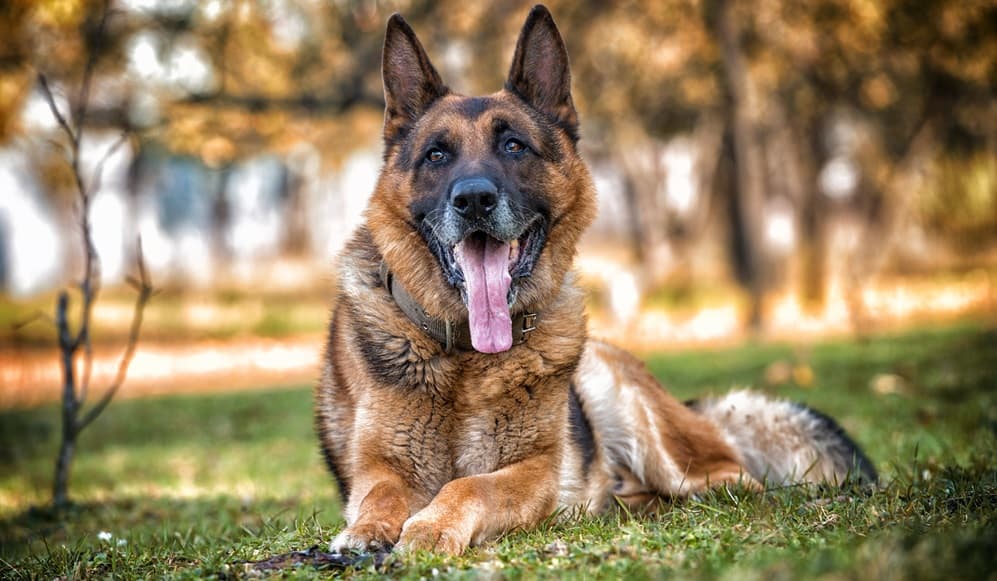
If you have been raising your German Shepherd puppy since he was a young puppy, you might be asking yourself now whether he is finished growing or when he will finish growing, especially since the breed can get quite large.
The truth is that there is not one solid answer. The growth rates can vary from dog to dog. So when do German Shepherds stop growing?
Some German Shepherds will be finished growing when they are 18 months old. Others will keep growing until the age of 2 years old. There are even certain types of German Shepherds that will continue to grow until 3 years old.
Normally, the growth will slow down dramatically by 12 months and any kind of growth that happens after that period will be minimal and very gradual. At 18 months, your German Shepherd should have reached his full height, but it can take longer to reach his final weight.
German Shepherd Weight Chart
| Age | Male Weight Range | Female Weight Range |
|---|---|---|
| 1 month | 5.5 – 9 lbs / 2.5 – 4 kg | 4.5 – 8 lbs / 2 – 3.5 kg |
| 2 months | 16 – 20 lbs / 6 – 9 kg | 11 – 17 lbs / 5 – 7.5 kg |
| 3 months | 22 – 30 lbs / 10 – 14 kg | 17 – 26 lbs / 8 – 12 kg |
| 4 months | 35 – 40 lbs / 16 – 18 kg | 31 – 35 lbs / 14 – 16 kg |
| 5 months | 40 – 49 lbs / 18 – 22 kg | 35 – 44 lbs / 16 – 20 kg |
| 6 months | 49 – 57 lbs / 22 – 26 kg | 44 – 49 lbs / 20 – 22 kg |
| 7 months | 57 – 62 lbs / 26 – 28 kg | 49 – 53 lbs / 22 – 24 kg |
| 8 months | 62 – 66 lbs / 28 – 30 kg | 53 – 57 lbs / 24 – 26 kg |
| 9 months | 64 – 71 lbs / 29 – 32 kg | 55 – 60 lbs / 25 – 27 kg |
| 10 months | 66 – 73 lbs / 30 – 33 kg | 57 – 62 lbs / 26 – 28 kg |
| 11 months | 66 – 75 lbs / 30 – 34 kg | 60 – 64 lbs / 27 – 29 kg |
| 1 year | 71 – 75 lbs / 32 – 34 kg | 60 – 64 lbs / 27 – 29 kg |
| 1 ½ years | 71 – 79 lbs / 32 – 36 kg | 60 – 66 lbs / 27 – 30 kg |
| 2 years | 71 – 84 lbs / 32 – 38 kg | 62 – 66 lbs / 28 – 30 kg |
| 3 years | 79 – 88 lbs / 36 – 40 kg | 66 – 70 lbs / 28 – 32 kg |
German Shepherd Growth Chart
Just like humans, German Shepherds have milestones that they should make as they grow. Some of these involve height and weight while others involve behavior and socialization. See the German Shepherd weight chart above.
The stages can be divided into 5 primary categories: the neonatal period, the socialization period, the juvenile period, the sexual maturity period, and the transition into adulthood.
Stages Of GSD Development
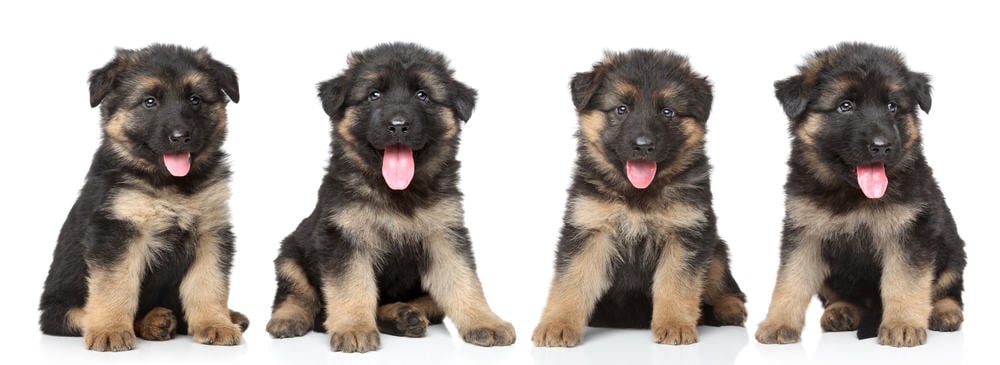
Neonatal Period: Birth – 3 Weeks
Right after birth is when a German Shepherd puppy is going to be most vulnerable. In the first three weeks of life, puppies will open their eyes, develop their hearing abilities, learn to crawl and to walk, and learn to go to the bathroom away from the rest of the litter.
They are small and delicate at this point. Their mother is completely responsible for feeding them, helping them urinate and clean up, as well as keeping them warm. It is best at this stage to let the mother do her part and allow her the space to mother without humans interfering with her.
Socialization Period: 3 Weeks – 12 Weeks
The period between 3 weeks of age and 12 weeks of age is known as the “socialization” period. During this phase of development, puppies will begin to interact with humans and the other dogs around them. It is important to their overall demeanor to get them accustomed to human interaction at this stage of life.
From weeks 3 to 8, the puppies should still be with their mother. They will become more coordinated and develop the skill of play. They can be weaned and housebroken at this time as well as developing the ability to bark when startled. Physically, you will see their ears now stand up.
Juvenile Period 3 Months – 6 Months
Between months 3 and 6, the puppies go through the “juvenile period.” The baby phase will have come to an end. They should be able to eat easily, interact with others, and should be on the brink of being housebroken. German Sheperd puppies will continue to grow and are ready to be trained.
They will begin to lose their milk teeth during this period. Continue to keep an eye out for the risk of chewing items that you might not approve of. Having dog-approved chew toys on hand can help both puppies get through the teething phase without frustration.
Sexual Maturity Period: 6 Months – 16 Months
A German Shepherd puppy between the ages of 6 months and 16 months will reach sexual maturity. By 16 months, your dog should have reached close to his full height. If you have no intention of breeding your German Shepherd, it is during this phase that you will want to have your dog spayed or neutered.
Talk to your vet about what the right timing is for spaying and neutering as well as what the risk is of your dog inadvertently mating. It is dangerous for a puppy to get pregnant, because her bones will not have fully developed.
Transition To Adult Period: 16 Months – 36 Months
Between 16 and 36 months, your puppy will be transitioning to adulthood. Some puppy behaviours should have calmed down, making way for more mature behaviours. Some German Shepherds continue to grow until 36 months, though most are done by 24 months.
While you will take them off of puppy food at this point, switching to adult food, you must continue to monitor their nutrition well to ensure that they are developing normally and are at a healthy puppy weight.
While they should still have a lot of energy, they also should have stopped chewing random items and calmed down slightly.
Dangers Of Stunted Or Accelerated Growth

New dog owners might be concerned about whether their dog is growing too quickly or too slowly, especially when you are comparing your pup to the German Shepherd growth chart. The danger of stunted growth only arises in the case of malnutrition or extreme disease.
If your puppy has not had proper nutrition or is having another affliction, there is a risk that he will not grow properly. Likewise, diet can cause your pup to grow too quickly.
In this case, the growth is not related to their bones, but their weight. Excess weight can harm a puppy’s growth and cause other health issues.
Do German Shepherds Still Grow After Being Neutered?
A common question among puppy owners is whether your German Shepherd will continue to grow after being neutered or spayed. The question is not so simple to answer. If you neuter your puppy, your puppy will continue to grow until he is an adult.
However, new science has indicated that if you neuter your puppy before he is fully grown, there is a greater risk that your puppy will develop hip dysplasia, arthritis, and even cancer in some dogs.
So, while neutering your German Shepherd when he’s young will not stop him from growing, it might harm them in other ways.
Average Adult German Shepherd Height
You measure a German Shepherd’s height from right above its shoulders (called the withers), which is the tallest spot on a German Shepherd’s back when he is standing up.
You never measure them by their head, because dogs cannot consistently keep their heads completely upright, so the shoulder is just easier.
Normally, male dogs are larger than female dogs, but that is not always the case. On average, a male German Shepherd will be 24 to 26 inches tall and a female German Shepherd would be 22 to 24 inches tall. The difference between the sexes is minimal when compared to other breeds.
It is important to remember as well that these are only averages. Your German Shepherd might be bigger or smaller, just as humans come in all shapes and sizes. Much of it will have to do with how large your dog’s parents were as well as the type of German Shepherd he is.
German Shepherd Height Chart
| Age | Male Height Range | Female Height Range |
|---|---|---|
| 1 month | 4 – 6” / 11 – 16 cm | 3 – 6” / 8 – 14 cm |
| 2 months | 7 – 9” / 17 – 22 cm | 6 – 9” / 14 – 22 cm |
| 3 months | 9 – 11” / 23 – 27 cm | 8 – 10” / 20 – 25 cm |
| 4 months | 11 – 14” / 29 – 35 cm | 10 – 12” / 26 – 31 cm |
| 5 months | 14 – 16” / 35 – 40 cm | 12 – 14” / 31 – 36 cm |
| 6 months | 16 – 18” / 41 – 46 cm | 15 – 17” / 37 – 42 cm |
| 7 months | 19 – 20” / 47 – 52 cm | 17 – 19” / 43 – 48 cm |
| 8 months | 20 – 22” / 51 – 56 cm | 18 – 20” / 45 – 50 cm |
| 9 months | 21 – 23” / 54 – 59 cm | 19 – 21” / 48 – 53 cm |
| 10 months | 22 – 24” / 55 – 60 cm | 19 – 21” / 49 – 54 cm |
| 11 months | 22 – 24” / 57 – 62 cm | 20 – 22” / 51 – 56 cm |
| 1 year | 22 – 24” / 57 – 62 cm | 20 – 22” / 51 – 56 cm |
| 1 ½ years | 23 – 25” / 59 – 64 cm | 21 – 22” / 53 – 55 cm |
| 2 years | 23 – 25” / 59 – 64 cm | 21 – 22” / 53 – 57 cm |
| 3 years | 24 – 26” / 60 – 65 cm | 22 – 24” / 55 – 60 cm |
When looking at the German Shepherd height chart, you will get a good idea of how quickly they grow and what you can generally expect as far as their height goes.
Looking at the German Shepherd height chart, you will notice that the puppies double in height between months 1 and 3 and again between months 2 and 4. The first 4 months of your puppy’s life is when you will see the largest amount of growth.
The height growth rate will slow down by 6 months. While your dog is nowhere near his final size, the amount that he grows each month will gradually reduce, so he will be growly less dramatically, while still growing.
This will help especially with feeding since you will be able to get him on a fixed amount after he has done his largest growth periods. You will notice on the charts that they keep going up until 3 years, taking into account any last bit of growth.
German Shepherd Body Condition Score (BCS)
Body Condition Score (BCS) is the equivalent of Body Mass Index in humans. It is a subjective rating that standardizes the weight level of animals to help create an exercise plan and diet that suits your puppy’s activity level, body, and lifestyle.
Body Condition Scale range from 1-9 or 1-5. The ideal BCS for your German Shepherd puppy should be 3/5 or 5/9. This is where the ribs, pelvic bones, and backbone have a very thin layer of fat and is easily palpable.
The tummy tuck should be seen from the side and the waistline should also be visible behind the ribs when seen from above.
How To Weigh Your German Shepherd Puppy
Weighing your German Shepherd is essential because it helps you to monitor their weight and ensure that they are in the right German Shepherd weight category for their age.
Generally, you should weigh your puppy once a year but weighing them twice per year will help you find any potential health issues at an early age.
However, if your puppy has a serious health condition, consider weighing them more frequently with the help of your vet.
You can use your bathroom scale to weigh your puppy. Ensure that the weighing machine reads zero and is placed on a hard, flat surface. First, weigh yourself and write down your weight. Then, pick up your German Shepherd puppy, step on the scale and record the weight.
To determine the weight of your puppy, subtract your weight from the combined weight of your puppy and you.
How To Help My German Shepherd Lose Weight If He Is Overweight
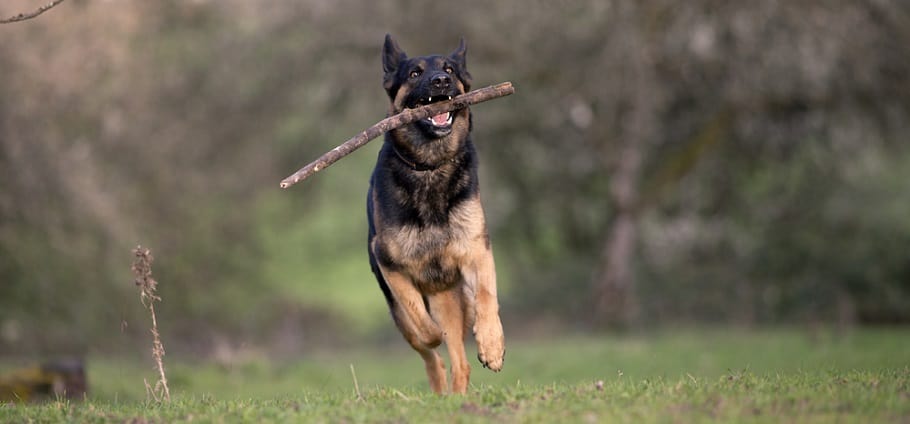
Excessive weight can lead to health complications in your German Shepherd puppy. If your German Shepherd is overweight, the following ways can help them lose weight:
- Reduce calories – first, you need to know the right number of daily calories your German Shepherd should be eating according to their age. Reducing between 10% and 20% is recommended, but you should seek advice and help from your vet when reducing the numbers.
- Reduce meals – if you are free-feeding your German Shepherd puppy, you should start feeding them at scheduled mealtimes. If you feed your puppy several times per day, ensure that you reduce the amount you are feeding them. Use measuring cups and evenly space mealtimes.
- Exercising – ensure that your German Shepherd is getting at least 1 hour of exercise every day then progress to 2 hours. Walking and jogging are some good exercises for your German Shepherd.
What Is A German Shepherd’s Neck Size?
Measuring your German Shepherd’s neck is important to help you find the perfect collar size to ensure that they are secure and comfortable.
To do this, use a measuring tape to measure loosely along the base of your puppy’s neck. Ensure that you can slide two fingers in between the tape and your puppy’s neck. The neck size of a German Shepherd is 18 – 24 inches (46-60cm)
Wolf vs German Shepherd Size
German Shepherds are known to be big dogs, but the largest of them is like the weight and size of the smallest wolf. On average, the height of wolves ranges from 26 inches to 32 inches while German Shepherds range from 22 inches to 26 inches.
The weight of a small female wolf is around 51 pounds and a big male wolf weighs around 180 pounds. Like dogs, male wolves grow longer, heavier, and taller than females. On the other hand, according to our German Shepherd size chart, they weigh between 49 pounds and 88 pounds.
Factors That Affect German Shepherd Growth
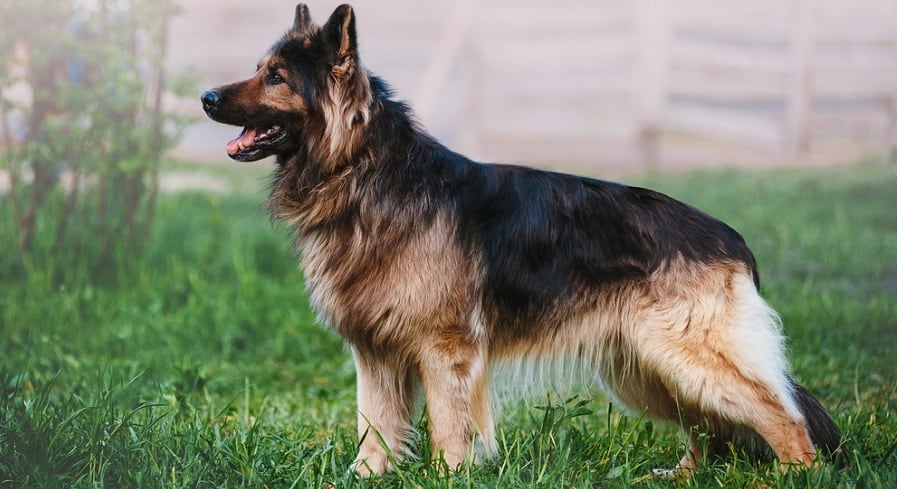
The following factors can affect the growth of your German Shepherd puppy:
Genetics
Like humans, genetics play a crucial role in the growth of dogs. The weight and size of the parents can hugely influence the growth of a German Shepherd puppy. For example, if the parents are shorter than average, there is a higher chance that the puppy will be short as an adult.
Additionally, German Shepherds are genetically predisposed to certain diseases including hip or elbow dysplasia, several allergies, and pancreatic disorders.
Sometimes, they might have problems with proper movement and angulation. These health problems can be transferred to the puppies which affects their growth.
Diet & Nutrition
The type of diet you are feeding your German Shepherd puppy influences its growth. A properly balanced diet and updating their diet plan with their developmental requirements are necessary to ensure that they reach their optimum growth.
Most owners think that since German Shepherds are large dogs, they need large portions of meals. But this is not the case as overfeeding can lead to excess weight gain causing diseases such as dysplasia and osteoarthritis.
To avoid this, speak to your vet to create a schedule for mealtimes for your puppy or research the feeding schedules for German Shepherd puppies.
Physical Activity & Health
Since German Shepherds are active dogs, they need plenty of exercise to stay active and healthy. A German Shepherd puppy needs 5 minutes of exercise every month old they are twice per day.
For example, if your puppy is 4 months old, they need 20 minutes of exercise two times a day.
Since German Shepherd puppies have a fast growth rate, overexercising them can lead to ligament and joint problems.
If your puppy is less than 5 months old, slow walks at the appropriate times are enough. You can introduce trekking and jogging after the age of 5 months.
At What Age Is A German Shepherd Fully Grown?
German Shepherds require more time to fill out their adult size in their abdomen and chest as well as reach their full height. Female German Shepherds are fully grown when they reach the age of around two years.
On the other hand, male German Shepherds grow to be bigger than female German Shepherds and are fully grown when they are about two and a half years old.
Some German Shepherds may continue to grow until they reach the age of three years, but most of the growth happens by 2 to 2½ years old.
Five Main Types Of German Shepherds
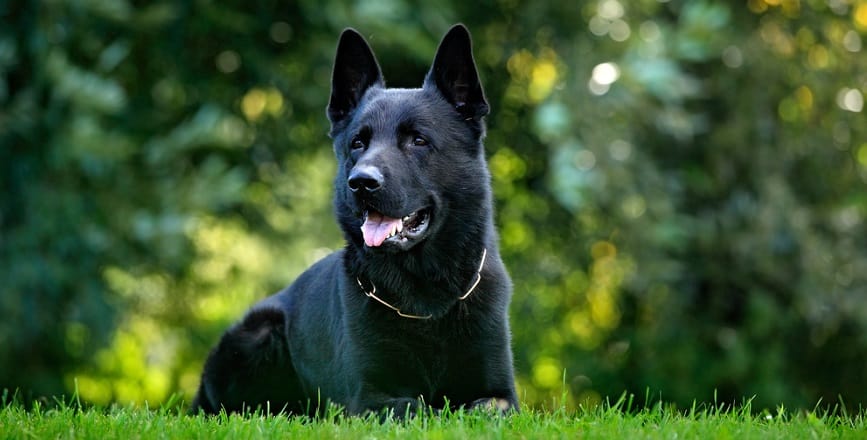
There are five main types of German Shepherds that you will come across:
- American Show Line German Shepherds: These are tall and long dogs. They can be black, tan, saddle, solid black, solid white, or even saddle sable, which is the most recognized coloring.
- West Show Line German Shepherds: These GS are intelligent and considered to be the most beautiful. They are usually black and red, black and tan, black, or sable in color.
- West Working Line German Shepherds: These are a calmer type of GS and are easy to work with. They can be sable, black, tan, or bi-color. They do have a higher risk of developing health issues.
- East Working Line DDR German Shepherds: This breed of GS are graceful and have very long coats. They are often used for search and rescue missions. They are the darkest breed of GS and are more usually just black and sable.
- Czech Working Line German Shepherds: This GS breed is incredibly loyal and they have broad shoulders and powerful jaws. They tend to have darker coats and their blacks do not slope. They are used for patrolling and make great police dogs.
How Long Are German Shepherds Pregnant?
German Shepherds are pregnant for around 63 days on average, measuring from the time of conception to the time of birth. Since German Shepherds are a large breed, sometimes, their gestation will take a little bit longer than other breeds, but it depends on the dog.
You should be able to keep track of conception as long as you have knowingly bred your dog, so have an exact date of conception to work from to get a better idea of the due date.
How Many Puppies Do German Shepherds Have?
While it can vary greatly from dog to dog, on average, German Shepherds have about 8 puppies at a time. 8 is a common amount for large breeds, but your dog could have less or more than that.
Beyond 8, you run the risk of puppies being too small or less healthy, since nutrients was being distributed thinly during gestation.
Generally, if you have kept your German Shepherd healthy and well-fed, you are likely to get more puppies. The number is also smaller if your dog gets pregnant on her first or second heat cycle.
German Shepherd Body Types
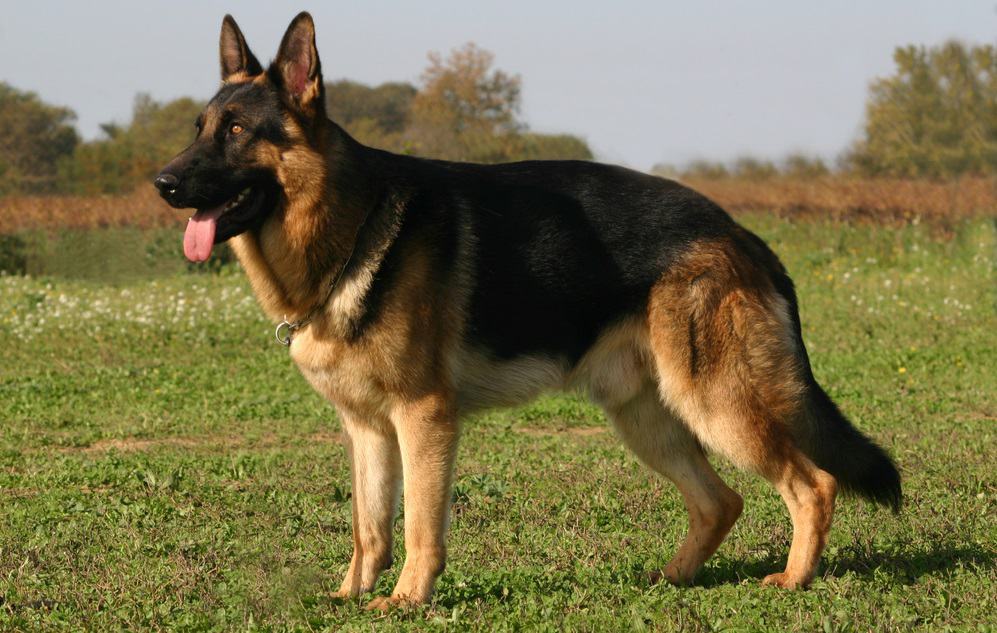
Just like with humans, there are various body types for German Shepherds. The ideal type is based on what humans decide is preferred and healthier for a German Shepherd’s needs.
To begin with, it is important to remember that German Shepherds are considered working breeds and need bodies that can perform their jobs well. A balanced frame will have a straight, flat spine with bones that are balanced between the front and back of the dog.
Dogs should be able to run and jump without any issues, which is true of most dog breeds.
For a German Shepherd, they need to be ready to hunt, guard, herd, and track. Their bodies need to help them complete their jobs without any physical limitations.
Show dogs will not be looked at for their work capabilities but based on the show standards. Unfortunately, often these standards of body types will not help your dog as active and healthy as he needs to be.
German Shepherds are prone to hip dysplasia as well as a roached back, which means a curved spine. Both of these conditions will affect the movement of your dog as he ages, making it difficult to run and walk well, let alone complete a job that they might attempt to do.
How Big Should A German Shepherd Be?
The size that your German Shepherd should be will depend mostly on the dog himself. Looking at the size of his parents, you should have a general idea of how big you can expect him to get.
If you don’t know how big his parents were, there are other factors to take into consideration.
When it comes down to it, you should be less focused on the averages and more focused on proportions. A German Shepherd should have a length-to-height ratio of 10:8.5 So if your German Shepherd is 28 inches long, he should be about 23.5 inches in height. You find this figure by multiplying his length by .85.
Weight-wise, you should be able to see his waist easily as well as find his ribs without trouble. If you can’t see the waist, he is overweight. If his ribs and spine are jutted out, he is underweight.
Do German Shepherds Have Common Health Problems?
All dog breeds have a tendency toward some kind of health problem. The severity and risk will vary, however. German Shepherds’ biggest issue is hip dysplasia.
This is when the hip bones do not sit well within the joint, making them easy to dislocate and injure. German Shepherds can also get elbow dysplasia, where the same thing happens, but with the elbow joint.
A major health concern that you will need to watch out for with German Shepherds is bloating. This is not like the type of bloating that humans experience and it can be life-threatening. It is where the dog’s stomach becomes distended to the point of cutting off air to the dog, causing trouble breathing.
It can be avoided by keeping your dog on a consistent schedule and not feeding him right before taking him out for vigorous exercise. You should also make sure your dog is not eating too quickly.
What Is The Life Expectancy Of German Shepherds?
Because German Shepherds are large-breed dogs, they do not live as long as smaller dogs. On average, you can expect your German Shepherd to live anywhere from 9 to 13 years.
This will be dependent on his tendency for health issues as well as the type of lifestyle he lives. His life can be prolonged with good food and exercise.
It is impossible to know for sure how long your German Shepherd will live, but keeping him vaccinated against harmful diseases, taking him to the vet at least once a year, and keeping him on a good exercise routine can increase his life expectancy.
How Much Does It Cost To Own A German Shepherd?
Adopting a German Shepherd is an important commitment. You need to be prepared to financially care for your dog for the entirety of his life, including food and visits to the vet. Adopting a dog from a breeder will also cost more than adopting your German Shepherd from a rescue or shelter.
The initial costs of a dog are higher because you need supplies. After that has been purchased, you can expect to pay about $1,000 a year for the best dog food for German Shepherds. Heartworm medicine is around $240 a year and a yearly visit of about $100, depending on the vet.
Additionally, you will need to factor in other costs for your dog. This means paying to have him microchipped if he wanders off as well as the spay/neutering surgery if that is what you would like to do.
You will also need to think about annual vaccinations, any tick medicine that you might want, as well as the cost of professional training if needed.
What If My German Shepherd Is Growing Too Fast
The most common cause of a puppy growing too fast is his diet. If you overfeed your puppy, your puppy will gain too much weight, but there is a bigger problem. Puppy food is so high in nutrition, that when you give a puppy too much, he will suffer from over-nutrition.
The puppies will take in too much protein, calcium, Vitamin D, and phosphorus and grow too quickly as a result. Since German Shepherds are prone to hip and elbow dysplasia, growing too quickly is dangerous for them. Talk to your vet about getting your puppy back on track.
What If My German Shepherd Is Over Weight?
If your German Shepherd is overweight, he is at risk of developing serious health conditions, like diabetes, heart disease, and cancer. It will also put too much pressure on his joints, causing arthritis and immobility. The heavier he is, the harder it will be to move and to lose the weight.
Look at his food – It should be high in lean protein, low in fillers and fat. Then, exercise your dog. Do not over-exercise or starve him to get him to lose weight. It will take time and patience to get him to a healthy weight.
Working vs Show German Shepherds Size Comparison
When adopting a German Shepherd puppy, you will need to consider whether you are looking for a working dog or a show dog.
While you might just be looking for a nice addition to your family, German Sheperd puppies have been bred for specific purposes for many years, resulting in dogs that are made to work and dogs that are not.
Working dogs need to have a lot more stamina and energy because they need to do a job. They do not have the same cosmetic attributes that you will find with show dogs, instead making up for it with incredibly athletic bodies that can move all day long.
Meanwhile, shows German Sheperds are bigger and bulkier and a lot less energetic. They have thicker coats, more color uniformity, and are bulkier in size. These make for better family pets because they do not require the same level of work to keep them happy.
Frequently Asked Questions
How can I use a German Shepherd growth chart?
To use a German Shepherd growth chart, compare your puppy’s current weight and height to the chart’s average ranges for their age, allowing you to monitor their growth progress.
What Is The German Shepherd’s Size?
Age/Height/Weight
- 1 month of age = 3 to 6 inches, 4.5 to 9 pounds
- 2 months of age = 6 to 9 inches, 16 to 20 pounds
- 3 months of age = 8 to 11 inches, 22 to 30 pounds
- 4 months of age = 10 to 14 inches 35 – 40 pounds
- 5 months of age = 12 to 16 inches, 40 to 49 pounds
- 6 months of age = 15 to 18 inches, 49 to 57 pounds
- 7 months of age = 17 to 20 inches, 57 to 62 pounds
- 8 months of age = 18 to 22 inches, 62 to 66 pounds
- 9 months of age = 19 to 23 inches, 64 to 71 pounds
- 10 months of age = 19 to 24 inches, 66 to 73 pounds
- 11 months of age = 20 to 24 inches, 71 to 75 pounds
- 1 year of age = 20 to 24 inches, 71 to 79 pounds
- 1.5 years of age = 21 to 25 inches, 71 to 79 pounds
- 2 years of age = 21to 23 inches, 71 to 84 pounds
- 3 years of age = 21 to 26 inches, 79 to 88 pounds
German Shepherd height is measured when they are standing up, from the bottoms of their paws to the top of their shoulders.
When does a German Sheperd puppy reach maturity?
German Shepherds typically reach full maturity between 18 months to 2 years of age, as their growth plates close, and they reach their adult weight and height.
How Much Bigger Will MyDog Get?
Obviously, there is a degree of personal differences and genetic variation that will affect how big your dog will get. There are a few things that you can look out for to give you clues on how big your dog will get.
A German Shepherd is a big dog that grows quickly – but, as is often true with big breeds, during puppyhood their paws are larger than their legs or body. So, you can guess at how big your dog will be based on the size of its feet!
In addition to this, the parentage of your dog matters when it comes to size. A German Shepherd weighs around 45 pounds, but the average size of a purebred GSD is about 50 pounds.
This means that if you buy a German Shepherd pup from a breeder, he or she will probably weigh more than 50 pounds.
What factors can influence the growth of a German Shepherd puppy?
Factors influencing a German Shepherd puppy’s growth include genetics, nutrition, healthcare, environment, exercise levels, and overall well-being.







